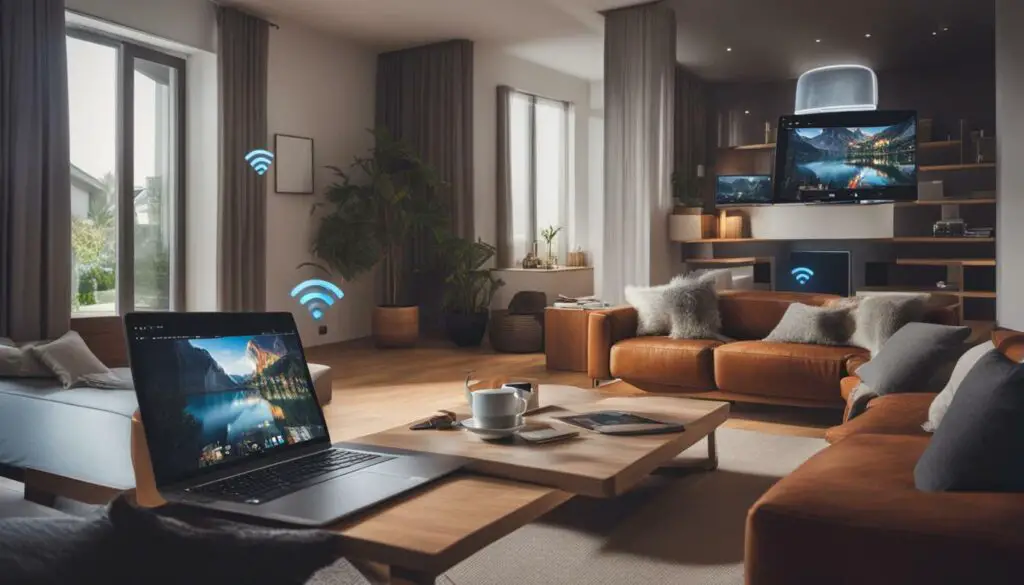Many people wonder if it is possible to have two modems in one house, and the answer is Yes.
Having multiple modems can offer several benefits, including increased bandwidth, improved security, enhanced WiFi coverage, and the ability to have multiple networks within your home. However, it’s important to consider the potential downsides and limitations as well.
Key Takeaways
- Having two modems in one house is possible and can provide advantages such as increased bandwidth and improved connectivity.
- Methods for connecting two modems include using splitters or utilizing bridge mode.
- Considerations when using multiple modems include the cost of purchasing a second modem and potential restrictions from internet service providers.
- Having multiple modems allows for separate networks and enhanced WiFi coverage throughout your home.
- It’s important to weigh the pros and cons before deciding to install a second modem in your house.
What is a Modem?
A modem, short for “modulator-demodulator,” is a device that converts digital data from a computer into the analog signal required by phone lines or cable systems and vice versa. Its primary role in Internet connectivity is establishing and maintaining a connection between your local network and your Internet Service Provider (ISP), allowing devices in your home or office to access the Internet.
In essence, a modem acts as a bridge between your local devices and the broader internet.
Benefits of Having Two Modems in One House
Having two modems in one house comes with several benefits that can improve your internet experience. Let’s explore the advantages of using multiple modems:
- Backup by Design – Having one modem configured as a backup for the other ensures a more stable connection, especially when one ISP faces an outage.
- Increased Bandwidth: With two modems, you can enjoy higher internet speeds and faster downloads. This is particularly beneficial for households with multiple users or devices accessing the internet simultaneously.
- Improved Security: Using two modems allows you to segregate your network traffic and create separate networks. This can help enhance the security of your devices by isolating them from potential threats on other networks.
- Enhanced WiFi Coverage: By strategically placing the two modems in different areas of your house, you can extend the range of your WiFi signal. This ensures better coverage throughout your home, eliminating dead zones and providing a consistent connection.
- Multiple Networks: Setting up two modems enables you to create separate networks, each with its own unique settings and password. This can be useful if you want to provide guest access or allocate different bandwidth priorities for specific devices or users.
The Challenges of Having Two Modems in One House
It’s important to note that while having two modems can be advantageous, there are some considerations to keep in mind.
- Firstly, purchasing a second modem means additional upfront and monthly costs.
- Additionally, some internet service providers may have restrictions or limitations on using multiple modems in one house. It’s essential to check with your provider to ensure compatibility and avoid any potential issues.
- Network Complexity: Proper setup and configuration are required to avoid network conflicts.

Methods for Connecting Two Modems in One House
There are two main methods for connecting two modems in one house, each with its own advantages and considerations.
1. Use a Splitter
Steps:
- Purchase a two-way splitter: Ensure the splitter is compatible with the type of cable used by your ISP. Usually, this is a coaxial cable.
- Locate the coaxial cable: Find the coaxial cable that runs from your wall outlet to your first modem.
- Connect the splitter: Disconnect the coaxial cable from the first modem and attach it to the input of the two-way splitter.
- Connect the modems: Use two new coaxial cables to connect from the splitter’s outputs to each modem.
- Notify your ISP: Before adding the second modem, notify your internet service provider. They can assess the signal strength and provide any necessary amplification. This is especially important as splitters will reduce the signal strength.
- Check for approval: Confirm with your ISP that it’s permissible to install a second modem based on your current contract and their policies.
- Buy and install the modem yourself: If the ISP doesn’t allow for a second modem but you still wish to proceed, consider purchasing your own modem and installing it yourself. Keep in mind that this may void any agreement with your ISP.
2. Use the Bridge Mode
Steps:
- Set up the primary modem: Install and set up your primary modem as you normally would, connecting it to your ISP and configuring your Wi-Fi network.
- Install the secondary modem: Connect the secondary modem to another outlet, if available. If not, use the splitter method.
- Access modem settings: Log into the web interface of the secondary modem. This is typically done by entering a specific IP address in a web browser, such as
192.168.0.1or192.168.1.1. - Enable bridge mode: Look for a setting named “bridge mode” or similar in the modem’s interface. This will essentially turn off the router functionality of the modem, allowing it to act as a gateway or a “cable” for another device.
- Connect the two modems: Using an Ethernet cable, connect one modem (acting as a cable in bridge mode) to the other modem (acting as a router).
- Configure as needed: The modem acting as a router can now host multiple devices, including a VPN for hiding the IP address, while the other modem provides the necessary internet connection bandwidth.
Additional Considerations:
- Security: If you’re looking for added security, consider having one modem exclusively for family members and the other for guests.
- Internet Speed and Coverage: Before adding a second modem, consider alternatives like upgrading your router, purchasing a mesh network system, or adding extenders to your network.
- ISP Compatibility: Not all ISPs permit the use of multiple modems. Always communicate with your provider before making changes to your network setup.
Final Note: If you’re unsure about any step, consider seeking help from a network professional or your internet service provider. It’s essential to ensure that your network remains stable and secure.

Pros and Cons of the Methods of Connecting Two Modems
| Method | Advantages | Considerations |
|---|---|---|
| Using a Splitter | – Simple setup – Cost-effective – Allows multiple connections | – Potential decrease in internet speed – Limited bandwidth |
| Bridge Mode | – Extended WiFi coverage – Separate networks – Better security | – Requires compatible modems – More complex setup – Additional cost |
Conclusion
In conclusion, having two modems in one house can offer various benefits, such as increased bandwidth, improved security, and enhanced WiFi coverage. However, it’s important to consider the potential drawbacks and limitations, including the cost and restrictions of your internet service provider. Make sure to weigh the pros and cons carefully before deciding to set up multiple modems in your home.
FAQs
Can you have two modems on one cable line?
Yes, you can have two modems on one cable line, but it requires proper setup and might not be supported by all ISPs. Typically, to achieve this, you’d use a cable splitter to divide the signal between the two modems.
However, there are some considerations:
- ISP Policies: Not all ISPs allow multiple modems on a single account or line.
- Signal Strength: Splitting the cable can weaken the signal, possibly affecting internet speeds or stability.
- Separate Internet Plans: Some ISPs might require you to have two separate Internet plans for each modem.
It’s essential to consult with your ISP before attempting such a setup.
Is it okay to connect modem to modem?
No, it’s not typical or recommended to connect a modem directly to another modem. Instead, modems should connect to routers or other networking devices for proper functionality.
Does having two routers slow down the internet?
No, having two routers doesn’t inherently slow down the internet. However, incorrect configuration can cause network issues.
If you face any issues with your existing modem try resetting it might solve the problem.
Can I use 2 cable modems for internet on different floors?
Yes, but each modem typically requires its own separate internet subscription or line from the ISP.
Why do some houses have two modems?
Some houses have two modems to manage multiple internet subscriptions, increase redundancy, or separate network activities.
- Epson EpiqVision Flex CO-W01 Projector Review - February 21, 2025
- How to Log in to Your Netgear Router - January 17, 2025
- Gaimoo GM200 Mini Projector Review - January 12, 2025




